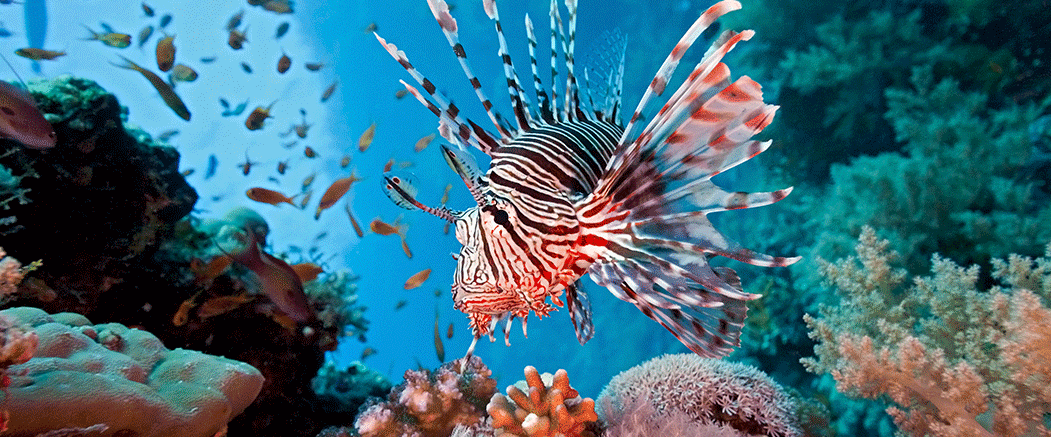Why leather from fishskin and fungi fibres are becoming the height of fashion
Alternative materials can help to reduce the clothing industry’s huge carbon footprint
By Jessica Rawnsley, Financial Times
As an avid scuba diver, Aarav Chavda was dismayed to witness the slow demise of the coral reef off the coast near his hometown in Florida. Over the years, the reef’s kaleidoscopic colours vanished along with the ocean dwellers it sustained —buffeted by rising global temperatures, warmer oceans and heat stress/pollution – until one day the entire reef was desolate, resembling a ghostly underwater grave. But there was one creature that thrived: the lionfish.
First imported for aquariums, lionfish are an invasive species that decimate reef ecosystems in the Caribbean, Atlantic and Gulf of Mexico. With no natural predators, each fish can gobble up to 70,000 native reef fish over its lifetime – devouring 79 percent of young marine life within five weeks of entering a habitat. Since 1960, invasive species (not just lion fish) have cost $ 1.2 trillion of damage in US waters alone and eaten into the livelihoods of thousands of local fishermen.
In 2020, Chavda and some other scuba divers devised an ingenious solution: turning lionfish skin into the world’s first invasive leather product that actively restores ecosystems. INVERSA, the company he founded, employs local hunters to catch the otherwise unprofitable fish, providing alternative livelihoods and dampening some demand for overfished species.
Partnering with fashion brands – 40 to date – Inversa turns the skin into exotic leather handbags, shoes, belts and footballs. The business now works across six countries and has expanded to incorporate two more invasive species: Burmese pythons from the Florida Everglades and carp from the Mississippi River. Some 50,000 invasive animals have been removed so far. “The game is 500,000, five million, 50 million,” Chavda says.
“Invasives are responsible for about 60 per cent of species extinctions around the planet today,” he continues. “The biggest challenge was that there wasn’t the scale needed to tackle this problem. And we see biodiversity bounce back in such a spectacular way: biomass regeneration is about 50 to 70 percent when there’s active management on a coral reef.”
“It’s exciting that fashion consumers can buy products that actively benefit the planet,” Chavda says. “It isn’t just a race to less bad or net neutral: we’re firmly regenerative and beneficial for the ecosystem.”
But Inversa is a small part of a solution to a greater global challenge, too: shrinking the environmental footprint of the leather — and wider fashion — industry .
The fashion industry contributes about 10 per cent of global carbon emissions, more than aviation and shipping combined. The bulk of that comes from the use of raw materials like cotton (requiring livestock agriculture and all the CO2 that entails) and synthetic materials like polyester (made from millions of barrels of crude oil each year). Then there’s the waste – billions of tonnes of discarded items dumped in landfills – the toxic chemicals and heavy metals, the microplastics that seep into the ocean, the land and water used.
“Fashion is one of the top five polluting industries and the majority of the impact comes from the materials being used,” explains Nina Marenzi, founder of The Sustainable Angle, a non-profit behind the annual showcase Future Fabrics Expo. “And we also know that climate change is going to have a huge impact on the materials being grown and be a risk to a brand’s bottom line.”
Yet the size and inherent ingenuity of the fashion industry also make it a potent vehicle for change. Thousands of startups and scientists are vying for a slice of the alternative materials pie. There are fibres made from seaweed, pineapple skin, cacti, fungi; cell-based leather grown in labs; textiles formed from agricultural waste.
“We’ve really moved from our initial starting point, which was focused on reduced environmental impact, to how materials can actually have a positive impact on people and planet,” says Marenzi. “It’s a crucial transition phase from looking at removing toxicity in the supply chain to how can you do better? Reduce waste? Absorb CO2 emissions in the growing phase?”
Uyen Tren grew up in Vietnam, surrounded by market stalls flush with second-hand waste from the West – clothing from Nike, Ralph Lauren, North Face. Later moving to America to pursue her designer dreams, she saw the other side of the coin: the high expense of repairing clothes and the limited wear of most items. Tackling fashion’s waste problem led her to experiment with chitin, a natural polymer extracted from shrimp shells, and a version of cellulose found in mushrooms. Tren partners with a supplier in Vietnam who gathers waste shrimp, crab and lobster shells and extracts chitin from them.
TômTex, her company, partners with luxury brands including Dauphinette and Peter Do on fully biodegradable capsule collections. “The principle is no plastic, no petrochemicals, no toxic chemicals,” she says. Tren and her scientists have taken to eating their material in the lab to illustrate its natural essence. “This beautiful material can mimic a lot of different things — leather, silicon, vinyl — but we wanted to go beyond that. Sustainable material can be seen as not sexy: we want to do things no one has seen before.” In the works are sheer, translucent materials that react with body temperature to change colour.
TômTex is itching for scale – a few years ago, the lab had 10,000 foot per year capacity, which has since soared to 100,000 square feet. Pilots are moving to production. Four of the latest brand partners will launch their designs at New York Fashion week in September.
But most innovators are currently working on relatively small scales. “The market is absolutely not realised at all by the finance industry and impact investors,” says Marenzi. “They were quite focused on green energy but nobody was really looking at materials and supply chain. The future is here now waiting to take off. And I think it needs a mindset change and more understanding of the finance industry that there’s a complete materials revolution underway and it could really accelerate if there was more money flowing in.”
Luke Haverhals, founder of Natural Fiber Welding (NFW) believes he’s cracked the code – and the company’s collaborations to date seem to indicate he might be right. A former chemistry professor, he had an “epiphany” one day in the lab. “Why do people use toxic synthetics when natural materials are more abundant, higher performing and nature produces them by sequestering carbon? It’s because plastics can be moulded into any shape. What if I could do what plastics do, but natural?”
He realised that natural inputs cost less than petro-chemicals and, if you could harness existing moulding and shaping industries, you wouldn’t need to reinvent the wheel. “In other words, I can work with a footwear manufacturing company and not have to change how you make a shoe,” Haverhals says. “I can give them the right material at the right price point, making all natural materials using existing infrastructure.”
So far NFW has made car seats for BMW, trainers for VivoBarefoot (which can be shredded and returned to the dirt), handbags for Stella McCartney, recycled-cotton polos for Ralph Lauren, including those sported by the US Olympics team in Paris, and rhinestone high heels for H&M. The company has raised about $185 million and is currently pursuing Series C funding to secure profitability.
“We can do things across trillions of dollars worth of industry,” Haverhals says. “We want this approach to ditch oil. Brands want to build a better world but didn't know how before. They didn't have time to reinvent their supply chain. So we mix up these doughs and get it to the people that are already moulding things out of plastic, but now they’re moulding natural recipes. And consumers don’t have to pay ten times more for BMW to do the right thing.
“Even if 10 per cent of what you could buy from Zara was NFW, that’s billions of dollars of business. We’re a seed that has sprouted, and you can tell we’re going to be an oak tree, but we’re not a forest of oak trees yet.”


